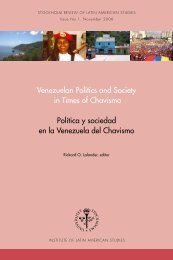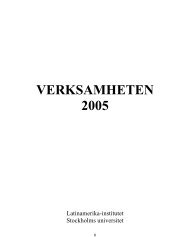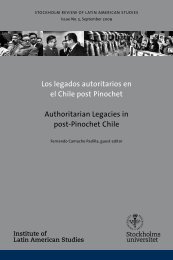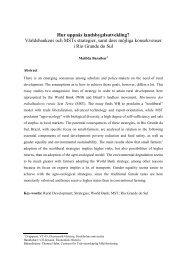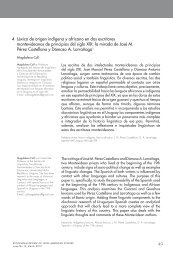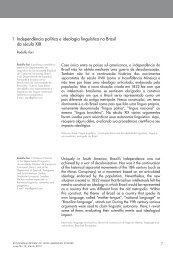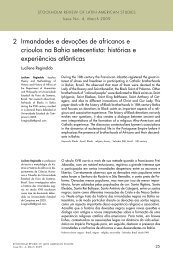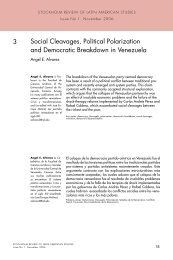aised in the previous decade with propaganda <strong>of</strong> dictatorial basis during 70‟s MilagreEconomico (Economic Miracle) 7 .After several years, and many unsuccessful attempts, the price rises finally got under controlwith 1994‟s Plano Real (Real Plan) that set down the inflation rates to less than 10% in its earlyyears 8 . Therefore, with a valuable currency, more Brazilians were able to travel abroad and tobuy imported products. Such enthusiasm, coincidently, arrived at the country together with a newworld wide medium, the internet, and – not so coincidently – with the cable televisionpopularization (that started in Brazil broadcasting exclusively foreign channels). Therefore, onewould say that the 90‟s were the time in which the Globalization Social Club – the associationthat is made between elite and Western European-North <strong>American</strong> culture in Brazilians‟ minds –got more evident for those who were in lower echelons <strong>of</strong> society, that were somewhat not aware<strong>of</strong> such correlation, by the gradual endeavour <strong>of</strong> different middle-class stratums to the world <strong>of</strong>the wealth.3. BRAZILIAN MEDIA PRODUCTION AND ITS CONSUPTIONWhile many western countries have much <strong>of</strong> their TV and Radio broadcasters‟ schedules basedon North-<strong>American</strong> productions, Brazilian networks lay upon local productions because theyunderstand that <strong>Latin</strong> <strong>American</strong> “audiences prioritize local content over foreign ones (…) Theideas (<strong>of</strong> such productions) can be global, but they work better when having a local protagonist”(Guglielmo, 2004: 208).Therefore <strong>Latin</strong> <strong>American</strong> TV networks invest on local productions such comedy, talk andreality shows that have their shape and/or story line somewhat based on foreign productions inorder to have higher audience rates. Through Rede Globo de Televisao 9 regular schedule, forexample, Brazilians can watch rather local versions <strong>of</strong> Late Show With David Letterman –Programa do Jô (Jô's Programme), a late-night talk show, hosted by the comedian and book7 The "economic miracle" is the name given to a period <strong>of</strong> an alleged exceptional economic growth occurred duringthe military dictatorship (between 1969 and 1973). This period brought up Brazilian pride through Statepropaganda (which made use <strong>of</strong> the Brazilian victory in 1970’s Football World Cup in Mexico as well as the fastBrazilian economic development at the time).8 During 1994-2000 period the inflation average was 8.6% a year in Brazil. In 2008 was 5.9%.9 Rede Globo de Televisao, or simply Globo, is the largest TV Network in Brazil, the fourth largest in the world, andhas an average daily audience <strong>of</strong> 120 million people (Globo Network Institutional.http://redeglobo.globo.com/TVG/0,,9648,00.html. Accessed on May 3 rd , <strong>2009</strong>).9
author Jô Soares, that aims to upper and middle Brazilian class-, as well as less elitist attractionsas Candid Camera, Reality and Game shows – Brazilian versions <strong>of</strong> Big Brother, <strong>American</strong> Idol,Are you Smarter Than a Fifth Grader?, Who Wants to Be a Millionaire?, among many others.Although all the aforementioned TV shows have their original versions somewhat modified, t<strong>of</strong>it better into Brazilians‟ frames, they apparently still attracting the same type <strong>of</strong> audiences thatthey draw in their countries <strong>of</strong> origin and, because <strong>of</strong> such previously translation, are seeing in arather similar way by both North-<strong>American</strong> (or European) and Brazilian people.As most <strong>of</strong> foreign productions have the necessity to be shaped into local audience frames inorder to have a higher audience, Brazilian terrestrial television networks reserve very few <strong>of</strong> itsschedule to purely foreign productions 10 . As TV sets are rather popular and democratic in Brazil– 97% <strong>of</strong> Brazilian population has a TV set regardless socio-economic positions 11 - despite othermedia such as Paid Television and Internet, one would argue that Brazilian terrestrial televisionnetworks‟ local orientation, even when making using <strong>of</strong> global ideas, reinforces the Braziliantrait as one <strong>of</strong> the less globalized societies in the world 12 -the country is placed in 116 th out <strong>of</strong>161 countries in the Social Globalization Index, while is ranked on 17 th on PoliticalGlobalization and 82 nd on Economic Globalization within the <strong>2009</strong> KOF Globalization Index.Peculiarity that makes the concept <strong>of</strong> the “Globalization Social Club” tw<strong>of</strong>old, as one wouldunderstand that globalization – or the chosen parameters to measure it- is also somewhat relatedto the wealth <strong>of</strong> a country.<strong>2009</strong> KOF Index <strong>of</strong> Social Globalization 13Position Country Points10 Just 8% <strong>of</strong> the weekly prime time schedule in Rede Globo is taken by foreign productions. It means that less than4 <strong>of</strong> 42 hours <strong>of</strong> Globo’s transmission, from 6pm to 12pm, are possible filled with movies (that can be either localor non-Brazilians). Moreover, according to Globo, around 90% <strong>of</strong> its whole schedule is homemade. (Globo NetworkInstitutional. http://redeglobo.globo.com/TVG/0,,9648,00.html. Accessed on May 3 rd , <strong>2009</strong>).11 The difference between TV sets in A class’ residences to D and E classes’ ones is <strong>of</strong> just 7%. Comitê Gestor daInformática no Brasil, TIC Domicilios e Usuarios, 2006. http://www.cetic.br/usuarios/tic/2006/index.htm .Accessed on May 3 rd <strong>2009</strong>-12 The KOF Social Globalization Index takes in considerations three distinct aspects <strong>of</strong> social globalization; (1)personal contacts, international telecom traffic, tourism flow –incoming and outgoing-, number <strong>of</strong> letters receivedand sent abroad, etc; (2) information flows, number <strong>of</strong> internet users, television sets and international newspaperstraded per thousand people; and (3) cultural proximity – number <strong>of</strong> imported and exported books, McDonalds’restaurants and Ikea shops.13 http://globalization.k<strong>of</strong>.ethz.ch/10
- Page 2 and 3:
AbstractThis article explores some
- Page 4 and 5:
displaced people in relation to the
- Page 6:
Colombian case as a particular cond
- Page 9 and 10:
displacement instead of rejecting d
- Page 11 and 12:
5. Inter American Court contributio
- Page 13 and 14:
Moreover, the displaced are subject
- Page 15 and 16:
fabric on which lies the basis of t
- Page 17 and 18:
assistance; the right to exercise b
- Page 19 and 20:
ordinating and improving assistance
- Page 21 and 22:
and brutalisation of the armed conf
- Page 23 and 24:
subjects a free legal consultation
- Page 25 and 26:
8. Conclusions: how can the protect
- Page 27 and 28:
ReferencesACNUR, Balance de la pol
- Page 29 and 30:
FAMIG (Fundación de atención al m
- Page 31 and 32:
Una comunidad de Pazfrente al Estad
- Page 33 and 34:
salud y la educación. La pérdida
- Page 35 and 36:
gobierno es: “ser propositivo y d
- Page 37 and 38:
esidente y a los refugiados que van
- Page 39 and 40:
paramilitares, las comunidades camp
- Page 41 and 42:
asesinado. 28 Esta afirmación fue
- Page 43 and 44:
Los habitantes desplazados solicita
- Page 45 and 46:
La segunda detención de Elkin Dari
- Page 47 and 48:
Comunidad decidió declarar en la C
- Page 49 and 50:
Comunidad de San José de Apartadó
- Page 51 and 52: Brigada XVII del Ejército. 62 Al d
- Page 53 and 54: la impunidad en que se mantienen, y
- Page 55 and 56: como la mafia o el narcotráfico, s
- Page 57 and 58: Ratifican su existencia como una Co
- Page 59 and 60: La autonomía de las comunidades ch
- Page 61 and 62: A violência no romance O matador d
- Page 63 and 64: “The characters are emptied of co
- Page 65 and 66: pelos leitores, confrontando o leit
- Page 67 and 68: No caso da segunda vítima, o que p
- Page 69 and 70: meios para um tratamento odontológ
- Page 71 and 72: acompanhado seu trabalho” (Melo 1
- Page 73 and 74: LINS, Paulo (1997): Cidade de Deus:
- Page 75 and 76: transformação social. O Direito d
- Page 77 and 78: Constituição deveria ser a expres
- Page 79 and 80: O problema central desta discussão
- Page 81 and 82: Transitórias. A revisão é mais a
- Page 83 and 84: ultrapassada, que reduz o Direito
- Page 85 and 86: construção do discurso do estado
- Page 87 and 88: socialismo; o povo de El Salvador e
- Page 89 and 90: inquisição. Ser espanhol era ser
- Page 91 and 92: existência de um suposto “pacto
- Page 93 and 94: da família.Outro aspecto important
- Page 95 and 96: AbstractIn the past two decades, gl
- Page 97 and 98: 1. Introduction„Globalization Soc
- Page 99 and 100: a. THE IMPORTANCE IN BEING PART OF
- Page 101: 1990). However certain authors argu
- Page 105 and 106: at home (…) and playing popular s
- Page 107 and 108: cannot afford, but is also a questi
- Page 109 and 110: Proportion of individuals that have
- Page 111 and 112: the distinction between the deterri
- Page 113 and 114: Routledge.Online References-2004 Un
- Page 115 and 116: IntroducciónEl presente trabajo se
- Page 117 and 118: datos históricos acerca del valor
- Page 119 and 120: producciones de La Gaceta, así com
- Page 121 and 122: En lo que refiere a los discursos p
- Page 123 and 124: marchar por algo, y si esta identid
- Page 125 and 126: de representaciones del pasado con
- Page 127 and 128: ApéndiceNota de La Gaceta, secció
- Page 129 and 130: Atte.-„Que se vayan los que no si
- Page 131 and 132: Ciudades blancas. Crónicas rojasLa
- Page 133 and 134: econocimiento de su condición de c
- Page 135 and 136: itmo de cumbia en esa zona que de l
- Page 137 and 138: Los pibes chorros todavía mantiene
- Page 139 and 140: El texto entra dentro de la línea
- Page 141 and 142: El 11 de febrero de 1999, Magdalena
- Page 143 and 144: Speranza, Graciela, “Cómo vivir
- Page 145 and 146: Sin la complejidad teórica de Ratz
- Page 147 and 148: pone el énfasis en la organizació
- Page 149 and 150: el siglo XX, no logra conformar un
- Page 151 and 152: primera) biografía sobre Raúl Pre
- Page 153 and 154:
Una rápida consulta a los periódi
- Page 155 and 156:
valiosos de la vida colectiva. Se t
- Page 157 and 158:
identificado como un caso de narrad
- Page 159 and 160:
La joven se refiere al arma que la
- Page 161 and 162:
Todas las veces en las que pudo mor
- Page 163 and 164:
atravesando una quinta a oscuras, c
- Page 165 and 166:
Notas:1 El proyecto consta de dos p
- Page 167 and 168:
Consumption society challenged: Bra
- Page 169 and 170:
due to unequal land distribution we
- Page 171 and 172:
Hence, the neo-liberal free trade a
- Page 173 and 174:
een to stand up to neo-liberalism a
- Page 175 and 176:
structural adjustment programs and
- Page 177 and 178:
a participant in the larger counter
- Page 179 and 180:
Löwy, Michael 2001. “The socio-r
- Page 181:
World Bank 2002. “What is empower







